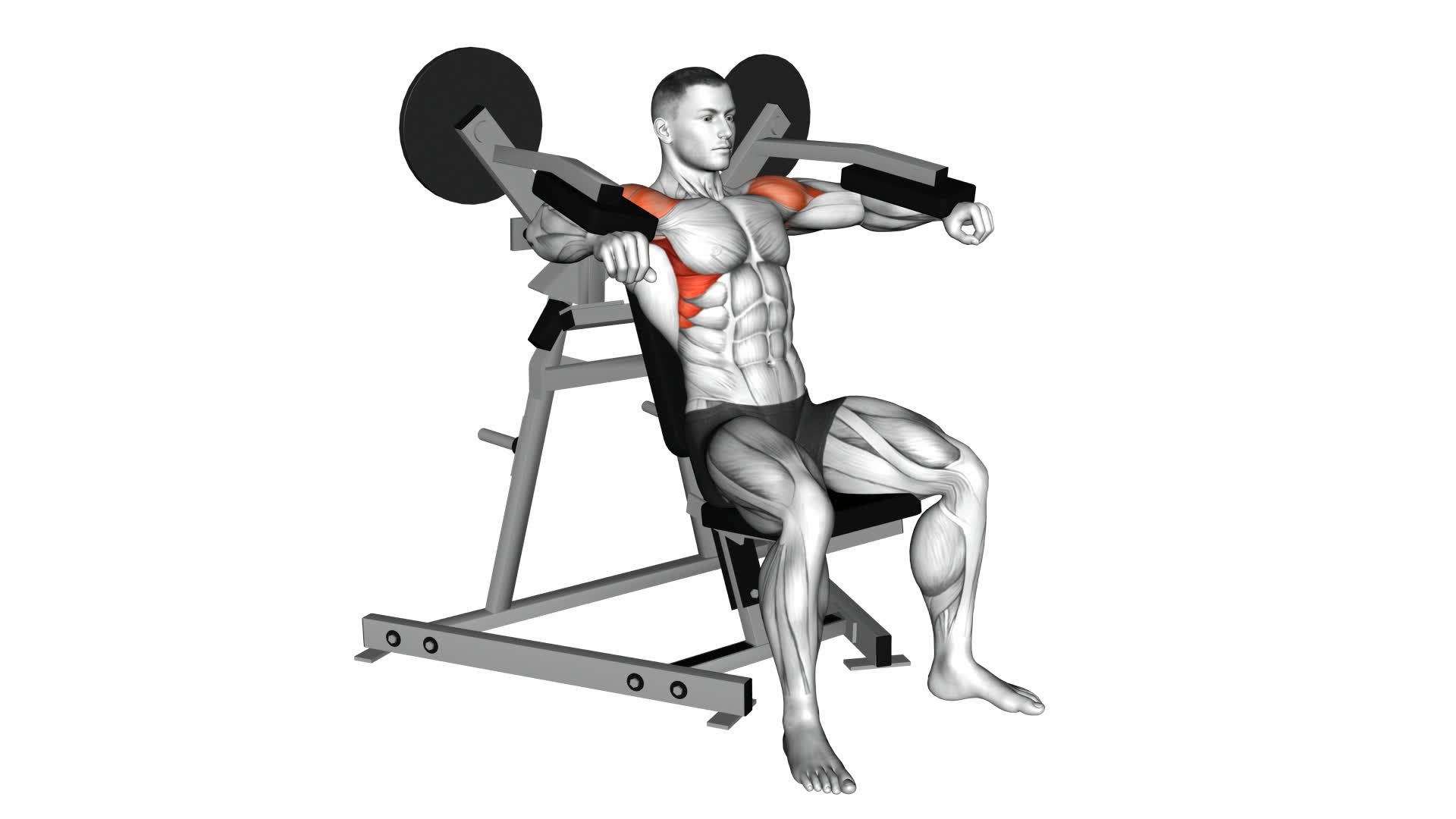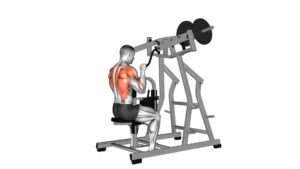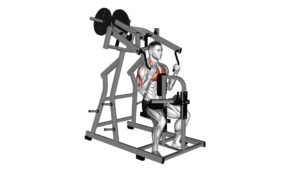Lever Lateral Raise (Plate Loaded) – Video Exercise Guide & Tips

Are you looking for a challenging shoulder exercise that targets your lateral deltoids? Look no further than the lever lateral raise.
Watch This Exercise Video
In this exercise, you'll be using a plate loaded machine to perform controlled lateral raises, effectively working your shoulder muscles.
This video exercise guide and tips will provide you with step-by-step instructions, common mistakes to avoid, and tips to increase the intensity.
Get ready to strengthen and sculpt your shoulders with the lever lateral raise.
Key Takeaways
- The lever lateral raise targets the lateral deltoids and strengthens and shapes the shoulders.
- It improves shoulder stability and mobility, as well as enhances posture.
- Performing the exercise correctly can help prevent shoulder injuries.
- Proper setup and equipment, along with avoiding common mistakes, are crucial for maximizing the benefits of the lever lateral raise.
Benefits of the Lever Lateral Raise
You will frequently experience the benefits of the Lever Lateral Raise, a plate loaded exercise. This exercise primarily targets your lateral deltoids, helping to strengthen and shape your shoulders. By regularly incorporating the Lever Lateral Raise into your workout routine, you can improve your overall shoulder stability and mobility. Additionally, this exercise can enhance your posture and help to prevent shoulder injuries.
One of the major benefits of the Lever Lateral Raise is its versatility. There are various ways to perform this exercise, allowing you to target different areas of your shoulders. You can adjust the starting position of the lever arm to change the angle of the movement, which in turn alters the emphasis on specific muscle groups. Furthermore, you can perform the exercise unilaterally or bilaterally, providing you with even more options for variation.
Incorporating the Lever Lateral Raise into your workout routine won't only improve your shoulder strength and stability but also enhance your overall upper body aesthetics. It's a highly effective exercise that can be customized to suit your specific goals and needs. Now that you understand the benefits, let's move on to the proper setup and equipment for this exercise.
Proper Setup and Equipment for the Exercise
To ensure a proper setup for the Lever Lateral Raise exercise, you'll need the correct equipment, such as a lever lateral raise machine or a plate-loaded lever lateral raise machine.
It's important to position yourself correctly on the machine, with your feet flat on the ground and your back against the backrest.
Correct Equipment for Setup
To ensure proper setup and equipment for the Lever Lateral Raise (Plate Loaded) exercise, always carefully select the appropriate weight plates. The correct equipment is essential for an effective and safe workout. Make sure to choose weight plates that are suitable for your fitness level and goals.
The setup requirements include using a lever lateral raise machine that's properly adjusted to your height and comfort. Ensure that the weight plates are securely attached to the machine, and that the handles are positioned correctly for your grip. By paying attention to these details, you can optimize your workout and minimize the risk of injury.
Now that you have the correct equipment, let's move on to discussing the proper exercise positioning.
Proper Exercise Positioning
Once you have ensured the correct equipment and setup for the Lever Lateral Raise (Plate Loaded) exercise, it's important to focus on proper exercise positioning. To maximize the effectiveness of this exercise and minimize the risk of injury, follow these tips:
- Stand with your feet shoulder-width apart, maintaining a stable base.
- Grasp the handles of the lever machine with an overhand grip, palms facing down.
- Keep your core engaged and maintain a slight bend in your knees.
- Position your elbows at a 90-degree angle, slightly in front of your body.
Raise the lever arms out to the sides, maintaining control and avoiding any swinging or jerking motions.
- Keep your shoulders down and back, with your chest lifted throughout the movement.
- Focus on the muscle engagement in your deltoids as you lift the weight.
Step-By-Step Guide on How to Perform the Lever Lateral Raise
Start by positioning yourself on the lever lateral raise machine with your feet shoulder-width apart and your knees slightly bent. Grab the handles with an overhand grip, making sure your palms are facing down. Engage your core and keep your back straight throughout the exercise.
Begin by exhaling and slowly raising the handles out to the sides until they're parallel to the floor. Hold this position for a brief pause, focusing on squeezing your shoulder blades together. Inhale and slowly lower the handles back down to the starting position. Repeat for the desired number of repetitions.
To add variation to the exercise, you can change the grip on the handles or use different weight plates for added resistance. Additionally, you can perform the exercise standing or sitting, depending on the available equipment.
Now that you have learned the step-by-step instructions and variations for the lever lateral raise, it's important to be aware of common mistakes to avoid during the exercise. By avoiding these mistakes, you can maximize the effectiveness of the exercise and reduce the risk of injury.
Common Mistakes to Avoid During the Exercise
When performing the lever lateral raise, it's important to be aware of common mistakes that can hinder your progress and put you at risk of injury.
One common mistake to avoid is using improper form, such as swinging or jerking the weight, which can strain your muscles and joints.
Another mistake to watch out for is overloading the weight, as this can lead to muscle imbalances and potential injury.
Improper Form Dangers
To prevent potential injuries, ensure that you keep your elbows slightly bent throughout the lever lateral raise exercise. Maintaining proper form is crucial to avoid the dangers of improper form and the risks of incorrect technique.
Here are two common mistakes to avoid:
- Locking your elbows: Fully extending your elbows puts unnecessary strain on the joints and can lead to injury. Keep a slight bend in your elbows to alleviate stress.
- Using momentum: Swinging the weights or using momentum to lift them reduces the effectiveness of the exercise and increases the risk of injury. Focus on controlled movements and engage the targeted muscles.
Overloading Weight Risks
To prevent potential injuries and ensure proper form, it's important to be mindful of the risks of overloading weight during the lever lateral raise exercise. Overtraining risks and muscle strain risks are two common dangers associated with overloading weight.
When you use weights that are too heavy or increase the weight too quickly, you put excessive stress on your muscles and joints. This can lead to overtraining, which can result in fatigue, decreased performance, and even injury.
Additionally, overloading weight can increase the risk of muscle strains, as your muscles may not be able to handle the excessive load. To avoid these risks, it's crucial to gradually increase the weight and listen to your body's signals.
Always prioritize proper form and consult a fitness professional if needed.
Tips to Increase the Intensity and Challenge of the Exercise
To truly increase the intensity and challenge of the Lever Lateral Raise exercise, you need to focus on incorporating additional weighted plates onto the lever arm. Here are some tips to help you increase the intensity and make the exercise more challenging:
- Increase intensity:
- Add more weight: Gradually increase the amount of weight you load onto the lever arm. Start with a weight that challenges you but still allows for proper form and gradually increase it as you get stronger.
- Decrease rest time: Shorten the rest periods between sets to keep your muscles engaged and increase the overall intensity of the workout.
- Exercise modifications:
- Slow down the movement: Instead of performing the exercise quickly, focus on slow and controlled movements. This will increase the time under tension and make the exercise more challenging.
- Perform drop sets: After completing a set with a heavier weight, immediately reduce the weight and continue the exercise. This technique helps to fatigue the muscles and increase the intensity of the exercise.
Incorporating these tips into your Lever Lateral Raise routine will help you push your limits, increase muscle strength, and achieve better results. Remember to always listen to your body and adjust the weight and intensity accordingly.
Safety Precautions and Modifications for Beginners or Those With Shoulder Injuries
For beginners or those with shoulder injuries, it's important to take certain safety precautions and make necessary modifications to ensure a safe and effective Lever Lateral Raise workout.
Safety modifications are crucial to prevent further injury and promote proper form. Firstly, it's recommended to start with lighter weights or no weights at all, especially for beginners. This allows you to focus on mastering the exercise technique and gradually increase the intensity as you gain strength and confidence.
Additionally, beginners or those with shoulder injuries should avoid lifting heavy weights or performing the exercise with a jerking motion, as this can strain the shoulder joint. Instead, focus on controlled and smooth movements throughout the exercise. It's also important to keep the shoulders relaxed and avoid shrugging during the movement.
If you have a shoulder injury, it's advisable to consult with a healthcare professional or a qualified trainer before attempting the Lever Lateral Raise. They can provide personalized modifications and exercises that are suitable for your specific condition.
Frequently Asked Questions
What Are the Primary Muscles Targeted During the Lever Lateral Raise Exercise?
During the lever lateral raise exercise, the primary muscles targeted are your deltoids, particularly the medial deltoid. This exercise helps to strengthen and define your shoulder muscles.
For beginners, it's recommended to start with lighter weights and focus on proper form and control. As you progress, you can increase the weight gradually.
Remember to always consult with a fitness professional before starting any new exercise routine.
Can the Lever Lateral Raise Exercise Be Modified for Individuals With Limited Shoulder Mobility?
If you have limited shoulder mobility, there are modifications you can make to the lever lateral raise exercise. It's important to prioritize shoulder-friendly exercises that won't exacerbate any existing issues.
By adjusting the range of motion or using lighter weights, you can still work the targeted muscles while minimizing strain on your shoulders.
Remember to listen to your body and consult with a fitness professional if needed for personalized modifications.
Is It Necessary to Use a Plate-Loaded Machine for the Lever Lateral Raise, or Are There Alternative Equipment Options?
When doing the lever lateral raise, it's good to know that you have options when it comes to equipment.
While using a plate-loaded machine is one way to do the exercise, there are also alternative equipment options available. These alternatives can provide different benefits and target your muscles in unique ways.
Should the Elbows Be Fully Extended or Slightly Bent During the Exercise?
During the lever lateral raise exercise, it's important to consider the position of your elbows. Should they be fully extended or slightly bent? This is a common question when performing this exercise.
The answer is that your elbows should be slightly bent throughout the movement. This allows for better shoulder engagement and reduces the risk of strain or injury.
The lever lateral raise exercise is great for strengthening the shoulders and improving overall shoulder stability.
Are There Any Specific Breathing Techniques to Follow While Performing the Lever Lateral Raise?
When performing the lever lateral raise, it's important to focus on your breathing techniques.
Inhale as you lower the weight and exhale as you raise it, engaging your core and stabilizing your body. This will help you maintain proper form and maximize the benefits of the exercise.
If you have limited shoulder mobility, you can modify the movement by bending your elbows slightly or using lighter weights.
Always listen to your body and make adjustments as needed.
Conclusion
In conclusion, the lever lateral raise is a beneficial exercise for targeting the lateral deltoids and improving shoulder strength. By following the proper setup and technique, you can effectively perform this exercise and avoid common mistakes.
To increase the intensity, consider using heavier weights or performing more repetitions. It's important to prioritize safety and make modifications if you're a beginner or have shoulder injuries.
Incorporating the lever lateral raise into your workout routine can help enhance your upper body strength and overall fitness.

Author
Years ago, the spark of my life’s passion ignited in my mind the moment I stepped into the local gym for the first time. The inaugural bead of perspiration, the initial endeavor, the very first surge of endorphins, and a sense of pride that washed over me post-workout marked the beginning of my deep-seated interest in strength sports, fitness, and sports nutrition. This very curiosity blossomed rapidly into a profound fascination, propelling me to earn a Master’s degree in Physical Education from the Academy of Physical Education in Krakow, followed by a Sports Manager diploma from the Jagiellonian University. My journey of growth led me to gain more specialized qualifications, such as being a certified personal trainer with a focus on sports dietetics, a lifeguard, and an instructor for wellness and corrective gymnastics. Theoretical knowledge paired seamlessly with practical experience, reinforcing my belief that the transformation of individuals under my guidance was also a reflection of my personal growth. This belief holds true even today. Each day, I strive to push the boundaries and explore new realms. These realms gently elevate me to greater heights. The unique combination of passion for my field and the continuous quest for growth fuels my drive to break new ground.







